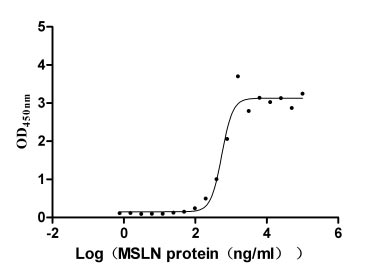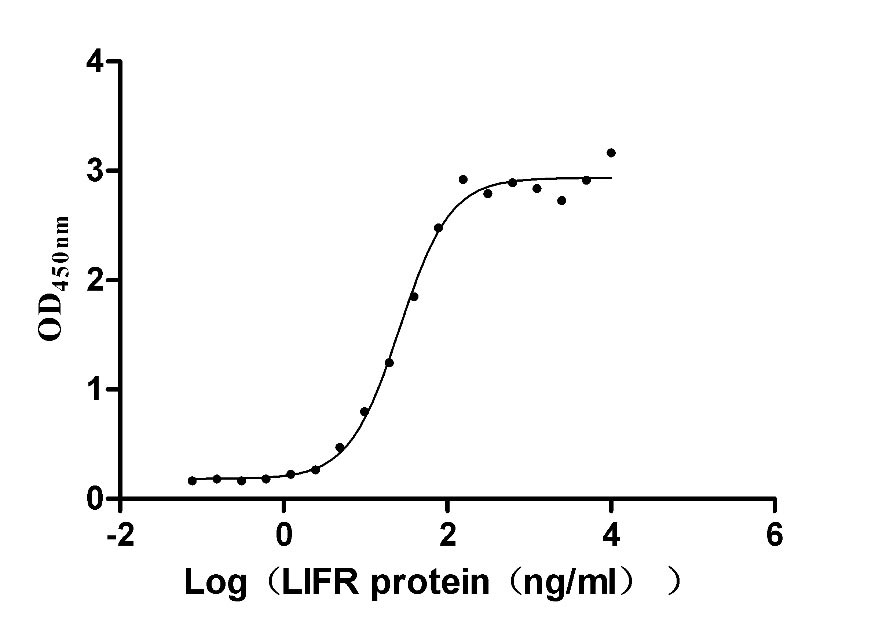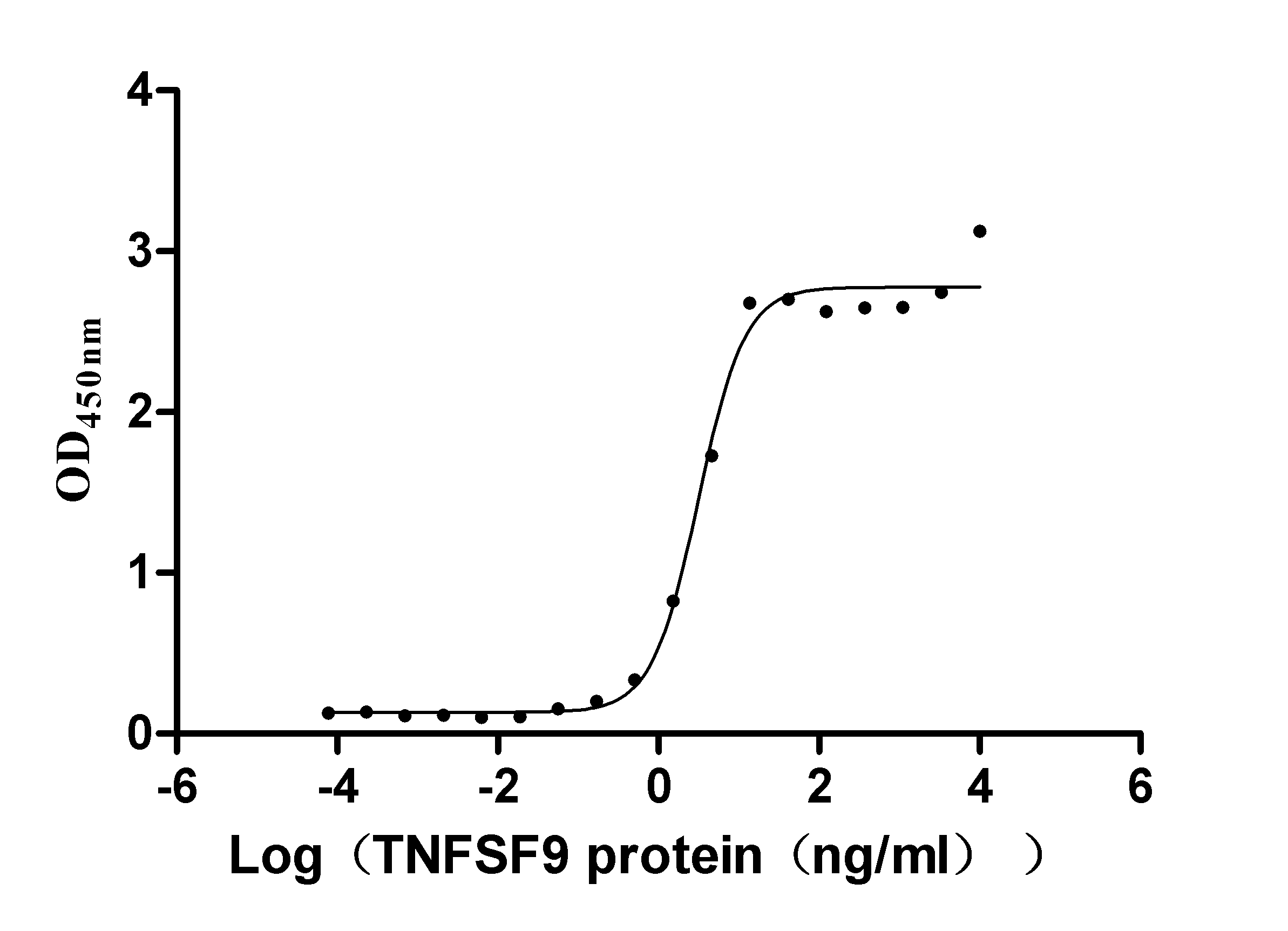Recombinant Human Gap junction alpha-3 protein (GJA3), partial
-
中文名称:人GJA3重组蛋白
-
货号:CSB-YP896931HU1
-
规格:
-
来源:Yeast
-
其他:
-
中文名称:人GJA3重组蛋白
-
货号:CSB-EP896931HU1
-
规格:
-
来源:E.coli
-
其他:
-
中文名称:人GJA3重组蛋白
-
货号:CSB-EP896931HU1-B
-
规格:
-
来源:E.coli
-
共轭:Avi-tag Biotinylated
E. coli biotin ligase (BirA) is highly specific in covalently attaching biotin to the 15 amino acid AviTag peptide. This recombinant protein was biotinylated in vivo by AviTag-BirA technology, which method is BriA catalyzes amide linkage between the biotin and the specific lysine of the AviTag.
-
其他:
-
中文名称:人GJA3重组蛋白
-
货号:CSB-BP896931HU1
-
规格:
-
来源:Baculovirus
-
其他:
-
中文名称:人GJA3重组蛋白
-
货号:CSB-MP896931HU1
-
规格:
-
来源:Mammalian cell
-
其他:
产品详情
-
纯度:>85% (SDS-PAGE)
-
基因名:GJA3
-
Uniprot No.:
-
别名:GJA3; Gap junction alpha-3 protein; Connexin-46; Cx46
-
种属:Homo sapiens (Human)
-
蛋白长度:Partial
-
蛋白标签:Tag type will be determined during the manufacturing process.
The tag type will be determined during production process. If you have specified tag type, please tell us and we will develop the specified tag preferentially. -
产品提供形式:Lyophilized powder
Note: We will preferentially ship the format that we have in stock, however, if you have any special requirement for the format, please remark your requirement when placing the order, we will prepare according to your demand. -
复溶:We recommend that this vial be briefly centrifuged prior to opening to bring the contents to the bottom. Please reconstitute protein in deionized sterile water to a concentration of 0.1-1.0 mg/mL.We recommend to add 5-50% of glycerol (final concentration) and aliquot for long-term storage at -20℃/-80℃. Our default final concentration of glycerol is 50%. Customers could use it as reference.
-
储存条件:Store at -20°C/-80°C upon receipt, aliquoting is necessary for mutiple use. Avoid repeated freeze-thaw cycles.
-
保质期:The shelf life is related to many factors, storage state, buffer ingredients, storage temperature and the stability of the protein itself.
Generally, the shelf life of liquid form is 6 months at -20°C/-80°C. The shelf life of lyophilized form is 12 months at -20°C/-80°C. -
货期:Delivery time may differ from different purchasing way or location, please kindly consult your local distributors for specific delivery time.Note: All of our proteins are default shipped with normal blue ice packs, if you request to ship with dry ice, please communicate with us in advance and extra fees will be charged.
-
注意事项:Repeated freezing and thawing is not recommended. Store working aliquots at 4°C for up to one week.
-
Datasheet :Please contact us to get it.
相关产品
靶点详情
-
功能:Structural component of lens fiber gap junctions. Gap junctions are dodecameric channels that connect the cytoplasm of adjoining cells. They are formed by the docking of two hexameric hemichannels, one from each cell membrane. Small molecules and ions diffuse from one cell to a neighboring cell via the central pore.
-
基因功能参考文献:
- novel mutation in GJA3 for autosomal dominant congenital cataract PMID: 28877251
- The study identified a missense mutation (c. 176C>T) in GJA3 gene associated with autosomal dominant congenital pulverulent cataract in a Chinese family. PMID: 27609163
- in vivo results indicated that down-regulation of GJA3 in lens epithelial cells was associated with age-related cataract genesis. Data from this study established the association of GJA3 down regulation with lens epithelial cells apoptosis and age-related cataract genesis PMID: 28088522
- the role of the charged residues at the end of TM-1 in voltage sensing in Cx26, Cx46, and Cx50. PMID: 27143357
- A novel missense GJA3 mutation that correlated with congenital cataract phenotype in a five-generation Chinese family. PMID: 26683566
- This study identified three mutations in three Chinese families with hereditary cataracts. Of the three mutations, two were novel (c.125 A > C in GJA3 and c.268 C > T in GJA3), one was previously reported (c.218 C > T in GJA8). PMID: 25549162
- The cataract related mutation N188T in human connexin46 revealed a critical role for residue N188 in the docking process of gap junction channels. PMID: 26449341
- A novel missense mutation, c.428G>A (p.G143E), in the GJA3 gene, localized to the cytoplasmic loop, was suggested to be the genetic cause of congenital nuclear cataract, which further expands the gene mutation spectrum. PMID: 25635993
- A novel GJA3 mutation (p.N55D) has been found in a Chinese family with congenital cataracts. PMID: 24728566
- The crystallin beta cluster on chromosome 22, GJA3, and BFSP1 play a major role in maintaining lens transparency. PMID: 24319337
- a GJA3 mutation in a Chinese family with congenital nuclear cataract PMID: 24772942
- these results suggest that mutation of this highly conserved residue on the cytoplasmic loop domain of Cx46 enhances its interaction with the C-terminus, resulting in a reduction of gap junction channel function PMID: 24019978
- A 1361 insertion of a cytosine mutation in the C-terminus of GJA3 is found to be associated with autosomal dominant congenital coralliform cataract. PMID: 23592915
- Coexpression of mutant with wild-type Cx50 or Cx46 gives rise to hemichannels with distinct electrophysiological properties, suggesting that the mutant connexins form heteromeric channels with wild-type connexins. PMID: 23302783
- Suggest that Cx46 and Cx26 expression in breast cancer may improve the assessment of pathological response and refine intermediate prognostic subgroups of residual tumour classifications used after neoadjuvant chemotherapy. PMID: 23374644
- These data indicate that biophysical and structural studies are converging towards a view that the N-terminal half of the Cx protein contains the principal components of the pore and gating elements. PMID: 22825713
- the negatively charged aspartic acid residue at the third position of the N-terminus of hCx46 could be involved in the determination of the degree of metabolite cell-to-cell coupling and is essential for the voltage sensitivity of the hCx46 hemichannels. PMID: 22843197
- A c.427G>A transition in exon 2 of GJA3 co-segregated with the cataract in the family members and was not observed in 100 control patients. PMID: 22876138
- A novel mutation (p.F206I) in the fourth transmembrane domain of connexin 46 is associated with autosomal dominant congenital cataract in a three-generation Chinese family. PMID: 22550389
- Novel missense mutation in the second extracellular loop of the GJA3 protein was detected, causing coral-like opacities in a Chinese family. PMID: 22312188
- Cx46G2D of GJA3 is a novel mutation that was identified in a Chinese family with autosomal dominant nuclear pulverulent and posterior polar congenital cataracts. PMID: 21681855
- A recurrent missense mutation in GJA3 is associated with autosomal dominant cataract linked to chromosome 13q in a 5-generation Caucasian American family. PMID: 21897748
- A novel mutation in the connexin 46 (GJA3) gene associated with congenital cataract in a Chinese pedigree. PMID: 21647269
- A novel mutation in the GJA3 (connexin46) gene is associated with autosomal dominant congenital nuclear cataract in a Chinese family. PMID: 21552498
- The genetic mutation in GJA3, GJA8, and LIM2 may slightly contribute to the development of age-related cataracts. PMID: 21386927
- Two new mutations, one in GJA3 and the other in CRYBB2, were identified co-segregating along with the respective cataract phenotype within the families that were not seen in healthy controls from India or Germany. PMID: 21031021
- Novel missense mutation identified in first extracellular loop of connexin 46; this expands mutation spectrum of GJA3 in association with congenital cataract. PMID: 20431721
- Upregulation of connexin46 is associated with breast tumors. PMID: 20013805
- This finding is the first report of a mutation in the first transmembrane region of GJA3. PMID: 14627959
- The present study has identified a fifth mutation in GJA3, rendering this connexin gene one of the most common non-crystallin genes associated with autosomal dominant cataracts in humans. PMID: 15208569
- A novel CX46 missense mutation indetified in a large autosomal dominant congenital cataract Australian pedigree. PMID: 15286166
- We conclude that connexin 46 mutations might account for as much as 3.3% of the hereditary congenital cataract in the Indian population. PMID: 16254549
- This is the first report of a mutation in GJA3 causing autosomal dominant congenital cataract (ADCC) in this ethnic group. It is also the first reported cataract-causing mutation in the NH2-terminal region of the Cx46 protein. PMID: 16885921
- The congenital "ant-egg" cataract phenotype is caused by a L11S mutation in connexin46 (Cx46) located in the signal peptide domain. PMID: 16971895
- Particular form of Pelizaeus-Merzbacher disease involves mutation in connexin 46. PMID: 17492548
- This is a novel mutation identified in the second transmembrane domain of the connexin 46. PMID: 17615540
- Novel mutation (R33L) in the GJA3 associated with finely granular embryonal cataract. PMID: 17893674
显示更多
收起更多
-
相关疾病:Cataract 14, multiple types (CTRCT14)
-
亚细胞定位:Cell membrane; Multi-pass membrane protein. Cell junction, gap junction.
-
蛋白家族:Connexin family, Alpha-type (group II) subfamily
-
数据库链接:
HGNC: 4277
OMIM: 121015
KEGG: hsa:2700
STRING: 9606.ENSP00000241125
UniGene: Hs.130313
Most popular with customers
-
Recombinant Human Mucin-16 (MUC16), partial (Active)
Express system: Mammalian cell
Species: Homo sapiens (Human)
-
Recombinant Human Leukemia inhibitory factor (LIF) (Active)
Express system: Mammalian cell
Species: Homo sapiens (Human)
-
Recombinant Human Tumor necrosis factor ligand superfamily member 9 (TNFSF9), partial (Active)
Express system: Mammalian cell
Species: Homo sapiens (Human)
-
Recombinant Mouse Transthyretin (Ttr) (Active)
Express system: Mammalian cell
Species: Mus musculus (Mouse)
-
Recombinant Human Alkaline phosphatase, germ cell type (ALPG) (Active)
Express system: Mammalian cell
Species: Homo sapiens (Human)
-
Recombinant Human Serine/threonine-protein kinase receptor R3 (ACVRL1), partial (Active)
Express system: Baculovirus
Species: Homo sapiens (Human)
-
Recombinant Human Tumor necrosis factor ligand superfamily member 15(TNFSF15) (Active)
Express system: Mammalian cell
Species: Homo sapiens (Human)








-AC1.jpg)










